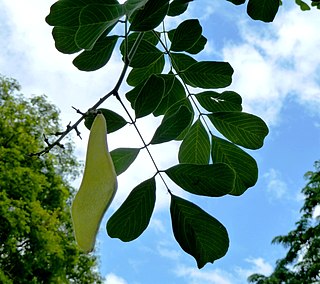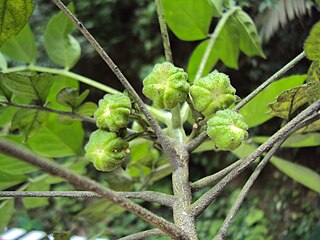
The plant tribe Phaseoleae is one of the subdivisions of the legume subfamily Faboideae, in the unranked NPAAA clade. This group includes many of the beans cultivated for human and animal food, most importantly from the genera Glycine, Phaseolus, and Vigna.

Robert Wight MD FRS FLS was a Scottish surgeon in the East India Company, whose professional career was spent entirely in southern India, where his greatest achievements were in botany – as an economic botanist and leading taxonomist in south India. He contributed to the introduction of American cotton. As a taxonomist he described 110 new genera and 1267 new species of flowering plants. He employed Indian botanical artists to illustrate many plants collected by himself and Indian collectors he trained. Some of these illustrations were published by William Hooker in Britain, but from 1838 he published a series of illustrated works in Madras including the uncoloured, six-volume Icones Plantarum Indiae Orientalis (1838–53) and two hand-coloured, two-volume works, the Illustrations of Indian Botany (1838–50) and Spicilegium Neilgherrense (1845–51). By the time he retired from India in 1853 he had published 2464 illustrations of Indian plants. The standard author abbreviation Wight is used to indicate this person as the author when citing a botanical name.

George Arnott Walker Arnott of Arlary was a Scottish botanist. He collaborated with botanists from around the world and served as a regius professor of botany at the University of Glasgow. An orchid genus Arnottia was named in his honour in 1828.

Pongamia pinnata is a species of tree in the pea family, Fabaceae, native to eastern and tropical Asia, Australia, and the Pacific islands. It is the sole species in genus Pongamia. It is often known by the synonym Millettia pinnata. Its common names include Indian beech and Pongame oiltree.

Entada is a genus of flowering plants in the family Fabaceae, in the mimosoid clade of the subfamily Caesalpinioideae. It consists of some 30 species of trees, shrubs and tropical lianas. About 21 species are known from Africa, six from Asia, two from the American tropics and one with a pantropical distribution. They have compound leaves and produce exceptionally large seedpods of up to 1.5 metres (4.9 ft) long. Their seeds are buoyant and survive lengthy journeys via rivers and ocean currents, to eventually wash up on tropical beaches.

Albrecht Wilhelm Roth was a physician and botanist born in Dötlingen, Germany.

Dunbaria is a genus of flowering plants in the family Fabaceae. It belongs to the subfamily Faboideae. It includes 19 species which range from India to Indochina, China, Korea, Japan, Malesia, New Guinea, and northern Australia.

Galactia is a genus of plants in the legume family (Fabaceae). It belongs to the subfamily Faboideae and tribe Diocleae They do not have an unambiguous common name, being commonly called milk peas, beach peas or wild peas. They are perennial herbs or subshrubs with prostrate, climbing, or erect forms.

The tribe Desmodieae is one of the subdivisions of the plant family Fabaceae. It is composed of two subtribes, Desmodiinae and Lespedezinae. Recent phylogenetics has this tribe nested within tribe Phaseoleae.

Cleghornia is a genus of plants in the family Apocynaceae. It includes two species, which are native to Borneo, China, Laos, Malaysia, Sri Lanka, Thailand, and Vietnam.

Abelmoschus angulosus is a plant species in the family Malvaceae, found in the Indian Subcontinent, Cambodia, Laos, Vietnam and Indonesia. It grows in temperate and wet regions between 750 and 2000 m, and is the only wild species of the genus Abelmoschus with a notable tolerance to low temperatures and light frost.

Micromelum minutum, commonly known as limeberry, dilminyin. kimiar margibur, tulibas tilos (Philippines), sesi (Indonesia) and samui (Thailand), is a species of small tree or shrub in the citrus plant family Rutaceae. It occurs from India and Indochina to Australia. It has pinnate leaves with egg-shaped to lance-shaped leaflets, hairy, pale green or creamish, scented flowers arranged in large groups and yellow to orange or red, oval to spherical berries in dense clusters.
Sida mysorensis, common name in India Mysore fanpetals, is a plant species native to South and Southeast Asia. It has been reported from the wild in Indonesia, Vietnam, Laos, Cambodia, Thailand, India, Pakistan and southern China, and is cultivated elsewhere. It grows in grassy slopes, on roadsides, and in forest boundaries.

Millettia stuhlmannii, commonly known as panga panga, is a well-known species of timber tree that is native to the southeastern Afrotropics. The wood of the tropical species M. laurentii has similar qualities and uses, but is slightly darker, and lacks the copious yellowish white resin of the heartwood vessels. Its foliage is similar to that of Pterocarpus rotundifolius, and it may be confused with the latter when observed from a distance.

Mezoneuron is a genus of flowering plants in the legume family, Fabaceae. It belongs to the subfamily Caesalpinioideae and the tribe Caesalpinieae.

Clauseneae is one of the two tribes of the flowering plant family Rutaceae, subfamily Aurantioideae, the other being Citreae, which includes Citrus.

Munronia is a genus of flowering plants in the family Meliaceae. Its native distribution is tropical and subtropical Asia.
















